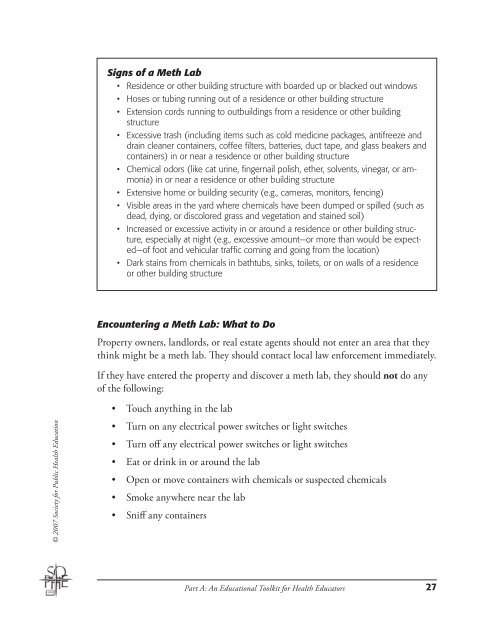Part A - Society for Public Health Education
Part A - Society for Public Health Education
Part A - Society for Public Health Education
- No tags were found...
Create successful ePaper yourself
Turn your PDF publications into a flip-book with our unique Google optimized e-Paper software.
Signs of a Meth Lab• Residence or other building structure with boarded up or blacked out windows• Hoses or tubing running out of a residence or other building structure• Extension cords running to outbuildings from a residence or other buildingstructure• Excessive trash (including items such as cold medicine packages, antifreeze anddrain cleaner containers, coffee filters, batteries, duct tape, and glass beakers andcontainers) in or near a residence or other building structure• Chemical odors (like cat urine, fingernail polish, ether, solvents, vinegar, or ammonia)in or near a residence or other building structure• Extensive home or building security (e.g., cameras, monitors, fencing)• Visible areas in the yard where chemicals have been dumped or spilled (such asdead, dying, or discolored grass and vegetation and stained soil)• Increased or excessive activity in or around a residence or other building structure,especially at night (e.g., excessive amount—or more than would be expected—offoot and vehicular traffic coming and going from the location)• Dark stains from chemicals in bathtubs, sinks, toilets, or on walls of a residenceor other building structureEncountering a Meth Lab: What to DoProperty owners, landlords, or real estate agents should not enter an area that theythink might be a meth lab. They should contact local law en<strong>for</strong>cement immediately.If they have entered the property and discover a meth lab, they should not do anyof the following:• Touch anything in the lab© 2007 <strong>Society</strong> <strong>for</strong> <strong>Public</strong> <strong>Health</strong> <strong>Education</strong>• Turn on any electrical power switches or light switches• Turn off any electrical power switches or light switches• Eat or drink in or around the lab• Open or move containers with chemicals or suspected chemicals• Smoke anywhere near the lab• Sniff any containers<strong>Part</strong> A: An <strong>Education</strong>al Toolkit <strong>for</strong> <strong>Health</strong> Educators27
















